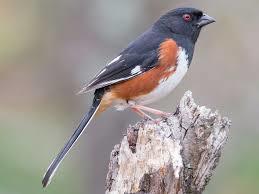Old Double Scratch
“The dead leaves fly before his attack!”
This is how Frank M. Chapman, curator of ornithology (1908–42) at the American Museum of Natural History, described the vigorous feeding habits of the towhee.
When foraging on the ground for seeds and small insects, Spotted and Eastern Towhees use a double-footed, backwards hop to scratch away the leaf litter. The sound of this furious activity is often the first clue to its presence, as towhees are usually shy and secretive and search for food while hiding under thick cover.
Until 1995, the Spotted Towhee and the Eastern Towhee were considered separate races of the same species, the Rufous-Sided Towhee. Now each is considered to a unique species. The two are very similar, except for the Spotted Towhee's white spots on its back and wings, and slightly different song. The Spotted Towhee is mostly a western U.S. bird while the Eastern Towhee, as its name implies, is found only in the eastern half of the country. The two species will interbreed where their ranges overlap.
Towhees seem to be a “feast-or-famine” type of visitor to feeders. You either have them on a regular basis or they provide you with just an occasional and sporadic glimpse. To increase your chances of seeing them at your feeders, we suggest you provide a good seed mix, like our Wild Birds Unlimited Deluxe Blend® that has the millet and sunflower seeds they prefer. Make sure to offer the seed in a hopper or ground tray feeder that allows the seeds to fall onto the ground so you can watch old “double scratch” at work.


